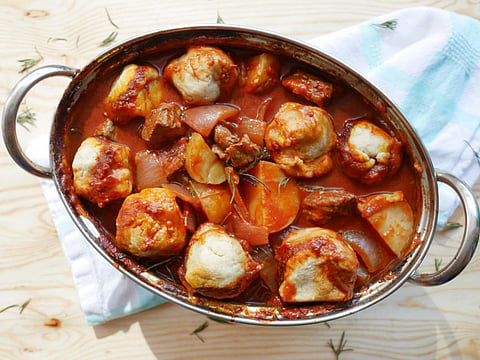Cooking With Mark: Beef stew and dumplings
This one-pot meal is perfect for sharing and any leftovers are great to freeze into individual portions

The word “stew” is said to come from the old French word estuier, meaning to enclose. Most cultures have a form of stew; most well-known is the Irish stew, “Ballymaloe” or “stobhach gaelach” as it is called in Gaelic. Made with either beef or lamb and root vegetables, I regard a stew as the ultimate in comfort food.
Sheep farming was popular across early rural Ireland. The wool would be used to make clothes and the milk would be used to make cheese, but as the animal came to the end of its productive years it would be slaughtered and eaten.
Because of its age, the meat would be tough; it would be cooked for hours so the meat would tenderise in the rich stock. Even today I use cheaper cuts of meat; it’s a great money-saving way to make a family meal.
My basic recipe is incredibly versatile — I use variations for pie fillings, or add potatoes and dumplings for a complete one-pot meal.
Growing up, a stew was served to us at least one weeknight, as being part of a large family a big pot of stew was an economical way to feed the many hungry mouths.
The pot would be placed in the centre of the table, from where it was served in bowls. It was a total potluck, and I always hoped my scoop would contain a large chunk of beef, or a fluffy dumpling.
The dough balls would be added to the pot 20 minutes before serving. They would cook in the sauce, becoming light and fluffy. Using a popular search engine I find the history of the dumpling dates back to medieval times, with the ancient method of stewing being popular all over the world. Dumplings and potatoes were added to soups and stews to make the dish more substantial and make it go further. Pulses are also added to bulk up the meal.
Our homemade stew was never the same; it depended on what was in season — swede, parsnips, carrots and celery were all added, left to simmer for hours on the coal stove. The windows would steam up as the pot bubbled away. The second-best part of the meal would be mopping up the gravy with slices of homemade bread.
The recipe alongside is one of my personal favourites. I have family in town right now, so this is the perfect sharing meal, and any leftovers are great to freeze into individual portions. In this recipe I use plenty of fresh herbs for extra flavour and I always make extra dumplings. It’s a real taste of nostalgia, and is still delicious.
BEEF STEW & DUMPLINGS
Serves 4, prep time 25 minutes, cooking time 1½ hours
INGREDIENTS
■ 1 tbsp of olive oil
■ 1 large onion quartered
■ 1 large carrot sliced
■ 1 red pepper
■ 500g of beef cuts cubed
■ 1 large tomato cubed
■ 6 new potatoes cubed
■ 1 tbsp of corn flour mixed with a little cold water
■ A handful of chopped parsley, keeping some to serve
■ 500ml of vegetable stock
■ 2 tbsp of tomato puree
■ 1 tbsp of Worcester sauce
■ 3 sprigs of fresh rosemary
FOR THE DUMPLINGS
■ 1 cup of self-raising flour
■ ½ cup of grated cold butter
■ Splash of water
■ Pinch of salt
METHOD
Preheat the oven to 180 degrees. Heat some oil in a pan, and then brown the beef. Turn off the heat and leave to stand. Place the onion, beef, carrots, tomato and peppers in an oven-proof dish. Pour in the stock, tomato puree and Worcester sauce. Stir and then top with potatoes. Pour in the cornflour mixture. Add the chopped parsley and rosemary, season, cover and place in the oven. Check after 45 minutes and stir once. Next, prepare the dumplings; put the flour in a bowl add the grated butter and rub together into bread crumbs. Add some water to bind the mix. When the mixture is dough-like, roll into equal balls. Remove the dish from the oven and arrange the dumpling balls around the edge of the dish. Cover and return to the oven for another 45 minutes. Finally, check if the potatoes are soft then remove the dish from the oven. Serve topped with the remainder of the parsley.
— Recipes, food styling and photography by Mark Setchfield, follow him on Instagram @gasmarksix
Sign up for the Daily Briefing
Get the latest news and updates straight to your inbox


